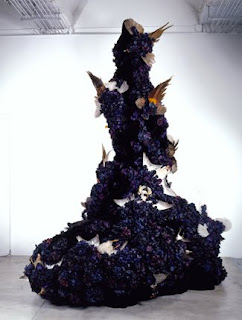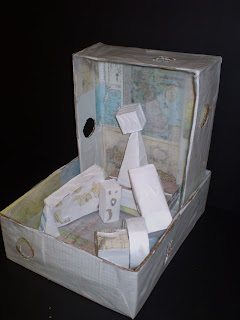Andrea Maack was born in 1977 and lives and works in Reykjavik, Iceland. Maack's main focus is sculpture, but her background in fashion and design heavily influences her work. In her work she takes inspiration in the process used by minimalist artists who sent their drawings to be executed by craftsmen, who then mass produced the work. She works with a lot of patterns that she then incorporates into her sculpture (recent work happens to be in the form of clothing). Maack also incorporates scents into her work because she also believes scent to be a pattern that fits together with her work at large. She got her BA in fine art in 2005 and displays mainly in Iceland and Nordic countries. However her work has been published internationally and displayed in New York as well.
Sunday, November 29, 2009
Andrea Maack
Andrea Maack was born in 1977 and lives and works in Reykjavik, Iceland. Maack's main focus is sculpture, but her background in fashion and design heavily influences her work. In her work she takes inspiration in the process used by minimalist artists who sent their drawings to be executed by craftsmen, who then mass produced the work. She works with a lot of patterns that she then incorporates into her sculpture (recent work happens to be in the form of clothing). Maack also incorporates scents into her work because she also believes scent to be a pattern that fits together with her work at large. She got her BA in fine art in 2005 and displays mainly in Iceland and Nordic countries. However her work has been published internationally and displayed in New York as well.
Saturday, November 28, 2009
Tallest Structure
Unfortunately due to computer malfunction, I lost a lot of my pictures (like in the former post). I don't have any pictures of the tallest structure. I had made an approximately 6'2" structure made out of foam core. Sept. 2009
Stacked Form
Tuesday, November 24, 2009
Paul Poiret
 Paul Poiret was a french couturier who was born in Paris, France on April 20, 1879 and died in his birthplace on April 30, 1944. He gave himself the title of "King of Fashion," and is most notated for freeing women of corsets and pantaloons. He also introduced the hobble skirt, which ironically enough restricted the way women walked. However what made Poiret truely innovative was how he cut and constructed his clothing taking into consideration the fact that he couldn't sew. He liked clothing cut along straight lines and made with rectangular pieces of fabric. His approach relied more on drapery skills because he worked directly on the body. His clothing was heavily influenced by Neoclassical and Orientalist styles, Eastern Art, and Russian Ballet. His designs were very theatrical, in deep, luxiourous purple, red, orange, green, and blue tones that epitomized the Pre-World War I era. Interestingly enough he also worked with art deco artist George Lepape, who illustrated Poiret's designs and called the collection Les Choses de Paul Poiret. Poiret's muse was his wife and they became notorious for throwing lavish parties to showcase his designs. Poiret was dethroned and basically forgotten with the arrival of Coco Chanel and her simple, impeccibly constructed designs.
Paul Poiret was a french couturier who was born in Paris, France on April 20, 1879 and died in his birthplace on April 30, 1944. He gave himself the title of "King of Fashion," and is most notated for freeing women of corsets and pantaloons. He also introduced the hobble skirt, which ironically enough restricted the way women walked. However what made Poiret truely innovative was how he cut and constructed his clothing taking into consideration the fact that he couldn't sew. He liked clothing cut along straight lines and made with rectangular pieces of fabric. His approach relied more on drapery skills because he worked directly on the body. His clothing was heavily influenced by Neoclassical and Orientalist styles, Eastern Art, and Russian Ballet. His designs were very theatrical, in deep, luxiourous purple, red, orange, green, and blue tones that epitomized the Pre-World War I era. Interestingly enough he also worked with art deco artist George Lepape, who illustrated Poiret's designs and called the collection Les Choses de Paul Poiret. Poiret's muse was his wife and they became notorious for throwing lavish parties to showcase his designs. Poiret was dethroned and basically forgotten with the arrival of Coco Chanel and her simple, impeccibly constructed designs. Petah Coyne
Petah Coyne was born in Oklahoma City in 1953 and is currently living and working in NYC. She graduated from Kent University in 1973 and the Art Academy of Cincinatti in 1977. Her work has been exhibited all over, but most notably at the Whitney Biennial in 2000. Her work consists mainly of large scale sculptures (as in 10ft.) made of a variety of materials, like wood, hay, soil, tar, chicken wire, sand, taxidermy, ribbons, hair, flowers, and bird cages. From those materials she creates lush surfaces that the viewer can easily caught up in. Petah refers to her sculptures as her "girls" and she explores the concept of how close beauty is to decay. Her sculptures are influenced by her study of art history, specifically Dutch still life and baroque sculpture, as well as her religious upbringing.
Visual Narrative
Visual Narrative based off my erasure poem titled
Questioning
She asks me if every intellectual is ever throwing up can't get rid of the other one, but in a different way the human race poor little new maiden is a strange type: traveling all over alone to see it for herself. That slim self with sights, visions! Everything passes her clear quiet eyes skirting the edge of obscene abysses without tearing her robe without knowing the injurious suspicions always passionless, stainless, fearless, charmless a little figure which, if you can get the right point of view, is rather striking
cardboard, copy paper, printed map graph paper, graph paper, tracing paper, hot glue, and gel medium, approx. 11" x 14" x 14", Nov. 2009

Questioning
She asks me if every intellectual is ever throwing up can't get rid of the other one, but in a different way the human race poor little new maiden is a strange type: traveling all over alone to see it for herself. That slim self with sights, visions! Everything passes her clear quiet eyes skirting the edge of obscene abysses without tearing her robe without knowing the injurious suspicions always passionless, stainless, fearless, charmless a little figure which, if you can get the right point of view, is rather striking

cardboard, copy paper, printed map graph paper, graph paper, tracing paper, hot glue, and gel medium, approx. 11" x 14" x 14", Nov. 2009

Subscribe to:
Comments (Atom)



































